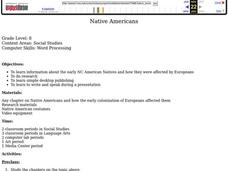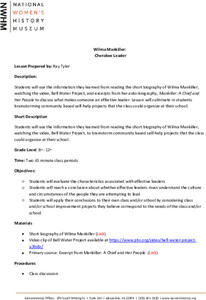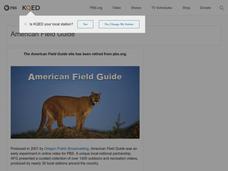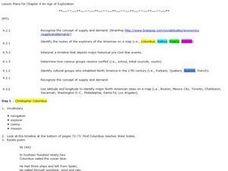Curated OER
Comparison of Colonial Regions in British North America
Students compare and contrast the colonies in British North America. As a class, they brainstorm a list of people, places and ideas associated with the Colonial Era. They discover the relationships and interactions between the...
Curated OER
Native American Friendship Dance
Students demonstrate the proper steps in sequence to the Native American Friendship Dance.
Curated OER
Americas: Political Map
In this North America and South America outline map worksheet, students examine the political boundaries of the 2 continents.
Curated OER
South American Architecture
Seventh graders review and discuss what they read about North American architecture. They then study images of North and south American architecture and make comparisons
Curated OER
Native American Ceremonies
Second graders explore cultural rituals by researching Native American people. For this Native American ceremony lesson, 2nd graders read the story Indian Festivals by Keith Brand and identify the naturalistic attitude of the Native...
Curated OER
Native Americans
Eighth graders are assigned a group of Native Americans from the North Carolina area to study. They research and write a paper, including sections on family, government, food, clothing, shelter, European contact, artifacts and give an...
Curated OER
Word Search: North American Animals
In this word search worksheet, students complete a 24 word puzzle, searching for names of North American animals. Worksheet is part of a site with many additional activities.
Curated OER
American Robin: Territory Study
Students read the article, American Robins: Territory Study, discussing the vocabulary, underlining key words, and taking notes. They write journal entries, and develop various writer's workshop assignments.
Race Briges Studio
I am Indopino: Or, How to Answer the Question, "Who Are You?"
In our increasingly multi-ethnic society, many learners find it difficult to identify themselves as belonging to any one ethnicity. Gene Tagaban, a Tlingit, Cherokee, Filipino offers his personal experiences with these questions in his...
Curated OER
The Cultural Significance of Naming
The Navajo would disagree with Shakespeare that the naming of things is irrelevant. Navajo people have to earn their names. Middle schoolers learn about the cultural significance of Navajo names in a lesson that uses a video and reading...
Channel Islands Film
Sa Hi Pa Ca (Once Upon a Time): Lesson Plan 2
What tools do archaeologists and anthropologist use to learned about what life was like in the past. After watching West of The West's documentary Once Upon a Time that details how scientists use artifacts to establish a history of the...
Channel Islands Film
Once Upon a Time (Sa Hi Pa Ca): Lesson Plan 3
What was the most significant tool used by the Chumash? How did the environment make the tool possible? What group behaviors allowed the Chumash be be successful for thousands of years? After watching West of the West's documentary Once...
Scholastic
The First Thanksgiving Feast for Grades 6–8
It's time for the feast! Young historians complete their study of the First Thanksgiving by completing an online activity, watching a slideshow, and examining a First Thanksgiving timeline. After answering text-dependent questions to...
K20 LEARN
Reconstruction Treaties Of 1866: The Reconstruction In Indian Territory
The Reconstruction Treaties of 1866 and their impact on the Five Tribes in the United States Civil War are the focus of a lesson that asks young historians to consider how these treaties affected tribal sovereignty. Class members do a...
K20 LEARN
Worcester v. Georgia: Cherokee Sovereignty and Actions of the U.S. Government
Young historians study the Supreme Court case "Worcester v. Georgia" and note instances where the Justices defended the sovereign rights of the Cherokee. They also examine the actions of President Andrew Jackson and the provisions of...
Curated OER
The Emancipation Proclamation Through Different Eyes
Students examine how various segments of the American population viewed the Emancipation Proclamation. They read the Emancipation Proclamation, analyze key terms and statements in the document, and participate in a debate.
Channel Islands Film
Lone Woman of San Nicolas Island: Lesson Plan 2
After watching West of the West's documentary The Lone Woman of San Nicolas Island, class members imagine how Juana Maria/Karana may have felt about living alone on the island for 18 years and craft a blackout poem or a narrative in her...
National Woman's History Museum
Sacagawea
Mind maps are great tools. Teach your classes how to use mind maps to collect, organize, and retain information with a lesson that asks learners to research the life of Sacagawea and use mind maps to record their findings.
National Woman's History Museum
Wilma Mankiller: Cherokee Leader
Middle and high schoolers consider the characteristics that make for a great leader. For example, they investigate Wilma Mankiller, the first female Principal Chief of the Cherokee Nation. Researchers read a short biography, watch a...
Scholastic
Harriet Tubman: Moses of Her People
Who was Harriet Tubman, and what was her place on the Underground Railroad? Recall the bravery and achievements of this extraordinary figure with a short, engaging informational text and crossword puzzle.
ReadWriteThink
Compare and Contrast
Read about the ways that different cultures set up homes with a set of reading activities. Learners read short paragraphs that cover one or more different ideas, and answer four questions about what they have read, including whether or...
Curated OER
The Formation and Value of Temperate Grasslands
Young scholars get an overview of the climate and organisms of the North American Prairie. After a lecture, and watching some videos imbedded in this plan, students compile research data on the North American Prairie.
Stanford University
Chicago Race Riots of 1919
Learners explore the Chicago Race Riots of 1919. In this American history lesson, students watch the move "Up South" regarding the African American migration following World War I. Learners read primary documents regarding the race riots...
Curated OER
An Age of Exploration
Students investigate U.S. history by examining North American timelines. In this American exploration instructional activity, students research the events that led to Columbus finding America and participate in a jeopardy game regarding...
Other popular searches
- North American Geography
- North American Biomes
- North American Indians
- American Northeast
- North American History
- North American Deserts
- North American
- North American Map
- North American Indian Tribes
- North American Climate Zones
- North American Explorers
- North American Dream

























